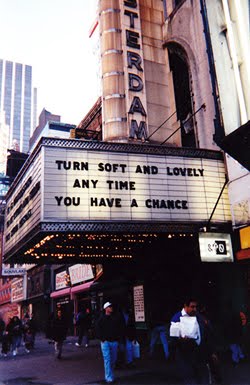Be careful who you choose as your friends.
Thursday, June 24, 2010
Tuesday, June 15, 2010
Back to the Nullabor Crossing
Thursday, June 10, 2010
…how should one make the most of a view? It turns out that the pattern which answers this question helps to govern not the rooms and windows on a building, but the places of transition. It helps to place and detail ENTRANCE TRANSITION (112), ENTRANCE ROOM (130), SHORT PASSAGES (132), THE STAIRCASE AS STAGE (133) - and outside, PATHS AS GOALS (120).
* * *
The archetypal zen view occurs on a famous Japanese house, which gives this pattern its name.
A Buddhist monk lived high in the mountains in a small stone house. Far, far in the distance was the ocean, visible and beautiful from the mountains. But it was not visible from the monks house itself, nor from the approach road to the house. However, in front of the house there stood a courtyard surrounded by a thick stone wall. As one came to the house, one passed through a gate into this court, then diagonally across the court to the front of the house. On the far side of the courtyard there was a slit in the wall, narrow and diagonal, cut through the thickness of the wall. As a person walked across the court, at one spot, where his position lined up with the slit in the wall, for an instant, he could see the ocean. And then he was past it once again, and went into the house.
What is it happens in that courtyard? The view of the distant sea is so restrained that is stays alive forever. Who, that has ever seen that view, can forget it? Its power will never fade. Even for the man who lives there, coming past that view day after day for fifty years, it will still be alive.
This is the essence of the problem with any view. It is a beautiful thing. One wants to enjoy it and drink it in every day. But the more open it is, the more obvious, the more it shouts, the sooner it will fade. Gradually it will become part of the building, like the wallpaper; and the intensity of its beauty will no longer be accessible to the people that live there.
Therefore:
If there is a beautiful view, don’t spoil it by building huge windows that gape incessantly at it. Instead, put the windows that look onto the view at places of transition – along paths, in hallways, in entry ways, on stairs, between rooms.
If the view window is correctly placed, people will see a glimpse of the distant view as they come up to the window or pass it: but the view is never visible from the places where people stay.
Put in the windows to complete the indirectness of the view – NATURAL DOORS AND WINDOWS (221); place them to help the TAPESTRY OF LIGHT AND DARK (135); and build a set from which a person can enjoy the view – WINDOW PLACE (180). If the view must be visible from inside a room, make a special corner of the room which looks onto the view, so that the enjoyment of the view becomes a definite act in its own right…
Zen View is pattern number 134, pp 641-43, of A Pattern Language – Towns, Buildings, Construction by Christopher Alexander, Sara Ishikawa and Murray Silverstein with Max Jacobson, Ingrid Fiksdahl-King and Shlomo Angel. Center for Environmental Structure, Berkley, California. New York Oxford University Press, 1977.













